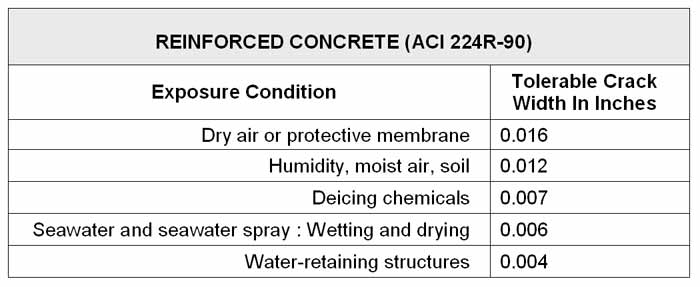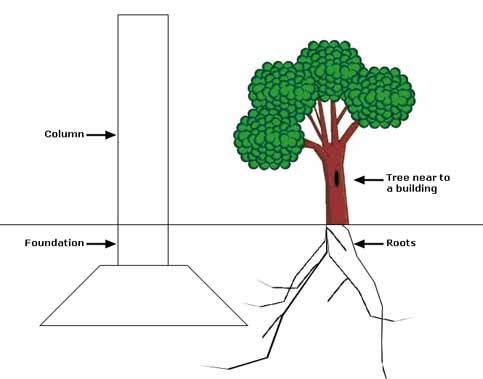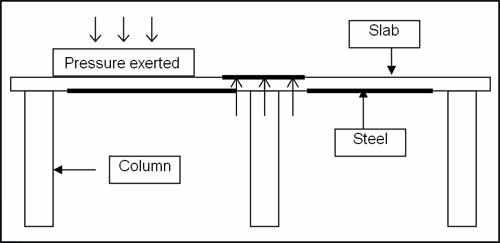| These
type of cracks occur, when the structure shows signs that
it cannot safely support the loads to which it was being
subjected. A majority of structural cracks occur as a result
of the following conditions:
• Design deficiency
• Construction deficiency
• Settlement or swelling of soil
• Reinforcement corrosion
Sometimes structural cracks manifest themselves with some
side effects. Doors and windows do not open and close easily.
Floors feel uneven. Vinyl flooring tears as a result of
crack movement. Plaster begins to show new cracks and even
interior corners may develop new cracks. Cracks can develop
along the length of the foundation as a result of corrosion
of reinforcement.
Types
of Structural Cracks
Rust
cracking:
Rust cracking is usually a result of corrosion of the reinforcing
steel or structural over stressing. The corrosion products
are more in volume than steel and these push the concrete
in cover region and cause cracks. Such cracks lead to further
corrosion. Typically these are seen running vertical in
columns and along bottom of the beams.
Inadequate reinforcement cover causes the most common and
most serious cause of structural cracking. It gradually
develops at varying rates over time depending upon the degree
of protection offered by the concrete cover.
Various anti-corrosive coatings are available in the market
to prevent the rusting and deterioration of concrete.
Some tolerable crack widths
along with their exposure conditions are given in the table.

Observed crack widths, however,
are not necessarily very good indicators of durability (the
structure’s resistance to corrosion and deterioration).
It may be (and ACI 224 states that is should be expected)
that some of the cracks in a structure will be significantly
wider than those in the table. The amount of concrete cover
over the reinforcement may be a better indicator of corrosion
resistance than crack width.
Another point to consider when
using this table is that it applies only to structural reinforced
concrete. These values should not be used to judge crack
widths in unreinforced or lightly reinforced slabs on grade
or in unreinforced basement walls. Also take into account
the high variability in crack widths. Isolated locations
where cracks are wider than those in this table 224 should
not be grounds for rejection or reduced pay.
Settlement Cracking
:
Settlement happens when parts of a house drop below the
elevation or height where they were placed during the original
construction. Settlement cracking in houses can be minimized
if precautions are taken. If building is on filled land,
make sure it is properly compacted. Settlement cracking
can also be caused due to overload on the foundation.
Geotechnical and soils engineers can perform soil tests
to make sure if the soil can support the building.
As you can see from the picture
below, which is a typical case for a settlement crack to
occur.

Removal of a big tree next to a house can cause
sudden changes in the soil moisture level and cause soil
movement.
Case 1 shows cracks due to tree removal.
Case
2 shows cracks due to plantation of a new tree.
Tension
cracking:
Such type of cracking occurs only in reinforced concrete
and is caused by elongation of the reinforcement (steel)
in tension zones.
It is sometimes seen around columns in flat slabs (slabs
resting directly on columns, without beams) and on beam
soffits (bottom side of beams) near the middle of a span.
Concrete has good compressive
strength, while steel has good tensile strength.
Steel bars are cast in positions where maximum tensile stresses
occur, which the concrete alone cannot withstand. Such a
combination of concrete and steel is called reinforced cement
concrete.

Tensile Strength : Ability
to resist forces that cause stretching.
Compressive Strength : Ability of a material
to withstand compression.
As seen in the picture above,
when there is a load on the slabs, pressure is created and
the steel at the lower portion of the slab takes all the
tension due to the property of the steel. When the steel
tends to stretch from the middle (where tension zone is
created), a reverse pressure is created at the junctions.
Thus additional steel is inserted at the junctions at the
top of the slab.
When in doubt, consult a professional concrete engineer
to investigate the cause of distress and evaluate the condition
of the concrete.
One could assist such a professional by keeping a periodic
record of :
• Crack progression
• Crack widths
• Landscape irrigation schedule, especially big tree removal
dates
|